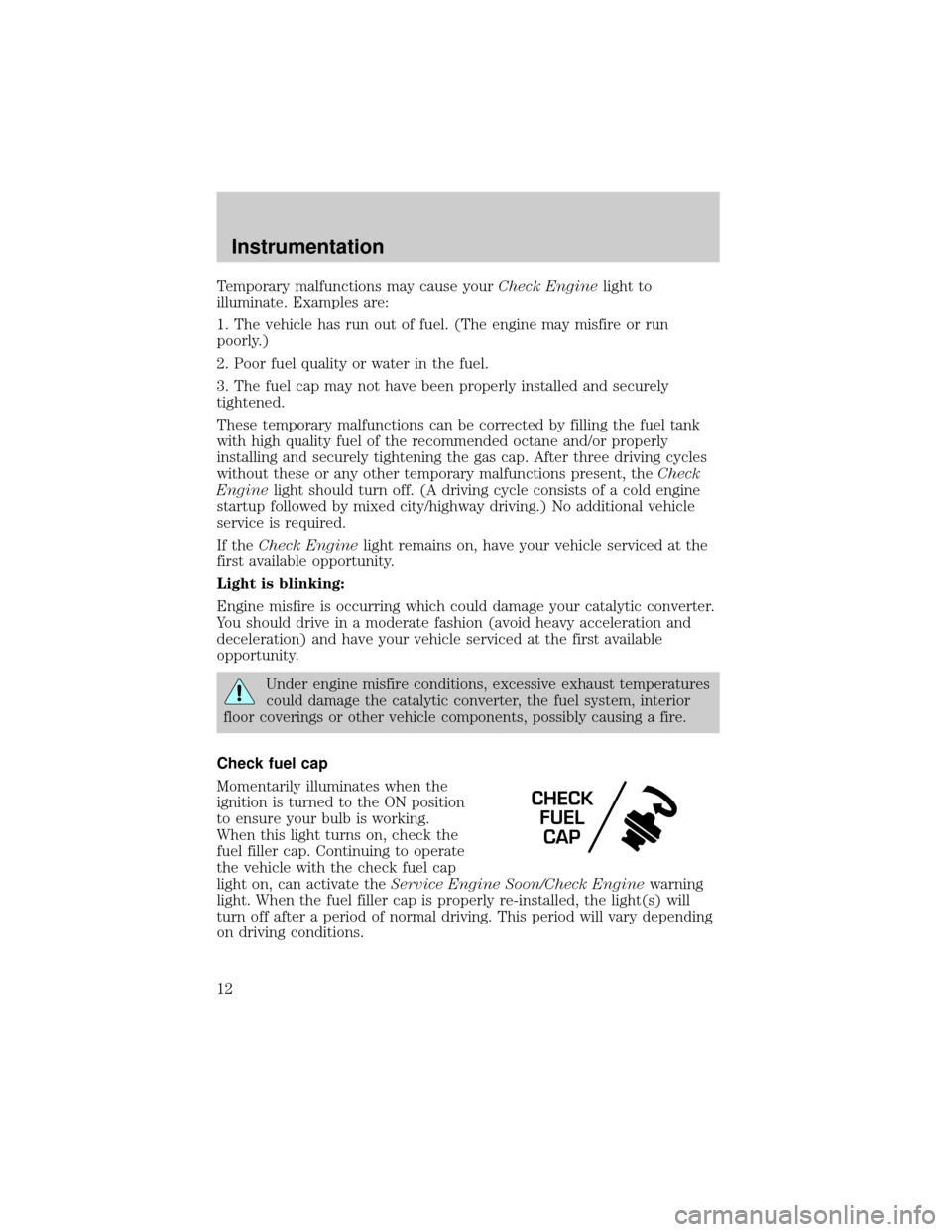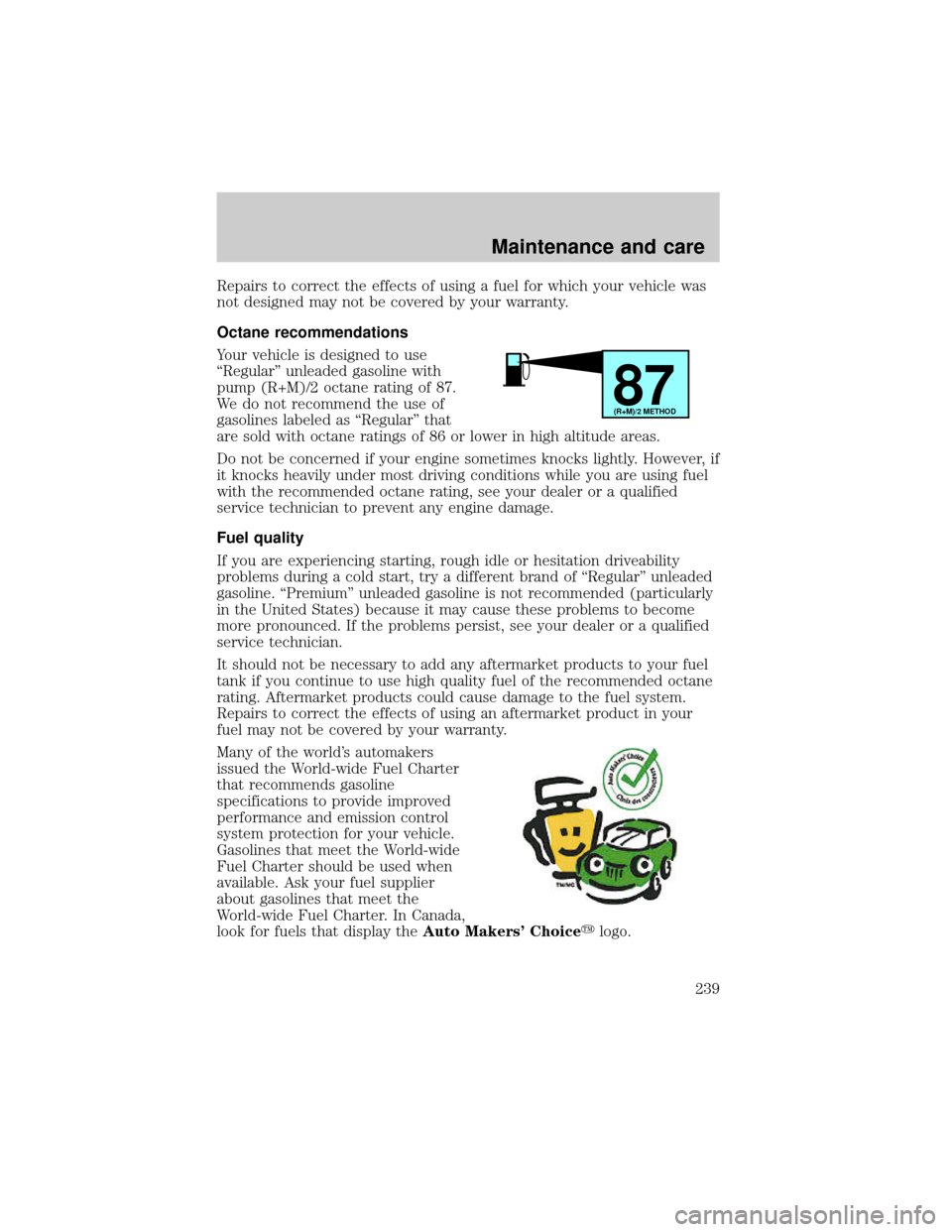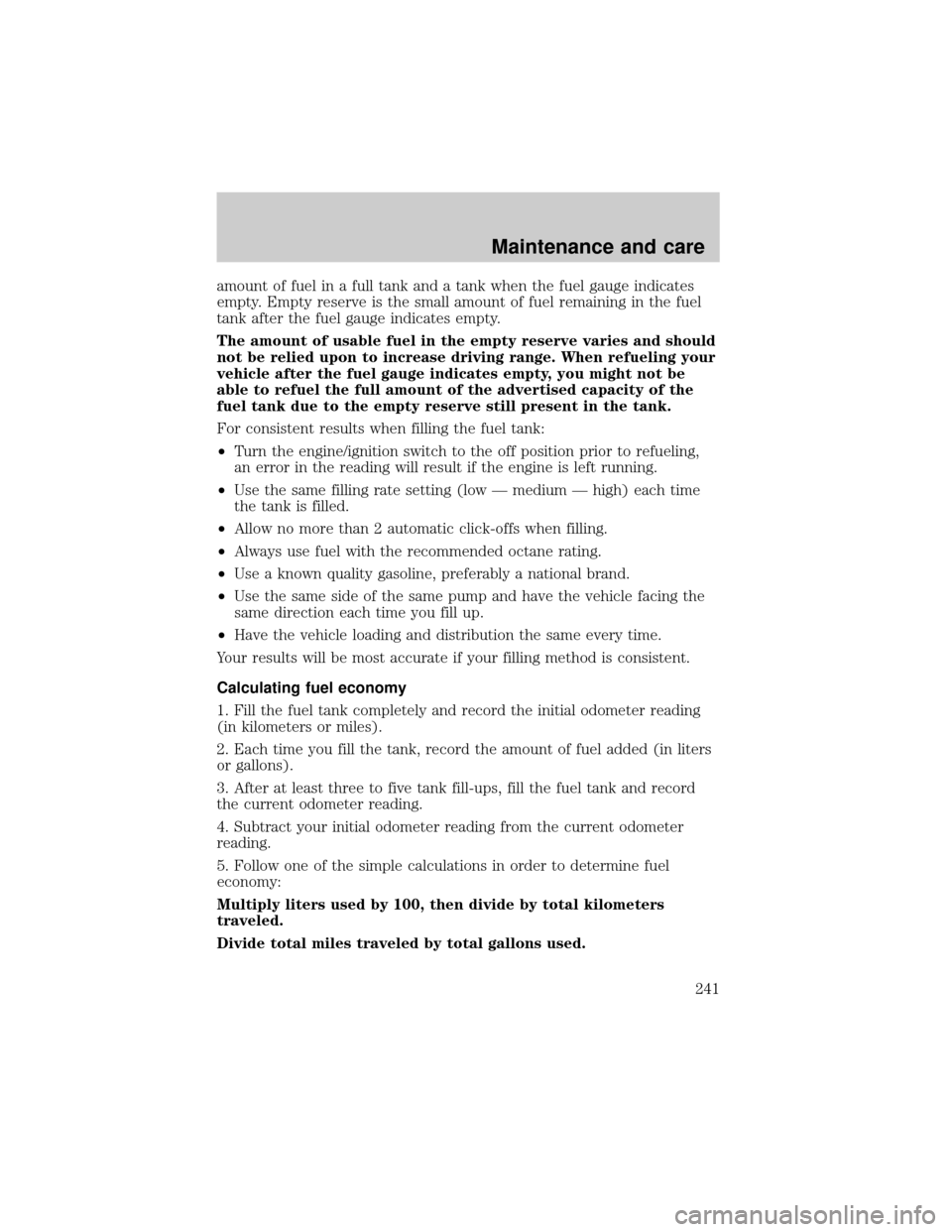2001 FORD WINDSTAR octane
[x] Cancel search: octanePage 12 of 288

Temporary malfunctions may cause yourCheck Enginelight to
illuminate. Examples are:
1. The vehicle has run out of fuel. (The engine may misfire or run
poorly.)
2. Poor fuel quality or water in the fuel.
3. The fuel cap may not have been properly installed and securely
tightened.
These temporary malfunctions can be corrected by filling the fuel tank
with high quality fuel of the recommended octane and/or properly
installing and securely tightening the gas cap. After three driving cycles
without these or any other temporary malfunctions present, theCheck
Enginelight should turn off. (A driving cycle consists of a cold engine
startup followed by mixed city/highway driving.) No additional vehicle
service is required.
If theCheck Enginelight remains on, have your vehicle serviced at the
first available opportunity.
Light is blinking:
Engine misfire is occurring which could damage your catalytic converter.
You should drive in a moderate fashion (avoid heavy acceleration and
deceleration) and have your vehicle serviced at the first available
opportunity.
Under engine misfire conditions, excessive exhaust temperatures
could damage the catalytic converter, the fuel system, interior
floor coverings or other vehicle components, possibly causing a fire.
Check fuel cap
Momentarily illuminates when the
ignition is turned to the ON position
to ensure your bulb is working.
When this light turns on, check the
fuel filler cap. Continuing to operate
the vehicle with the check fuel cap
light on, can activate theService Engine Soon/Check Enginewarning
light. When the fuel filler cap is properly re-installed, the light(s) will
turn off after a period of normal driving. This period will vary depending
on driving conditions.
CHECK
FUEL
CAP
Instrumentation
12
Page 239 of 288

Repairs to correct the effects of using a fuel for which your vehicle was
not designed may not be covered by your warranty.
Octane recommendations
Your vehicle is designed to use
ªRegularº unleaded gasoline with
pump (R+M)/2 octane rating of 87.
We do not recommend the use of
gasolines labeled as ªRegularº that
are sold with octane ratings of 86 or lower in high altitude areas.
Do not be concerned if your engine sometimes knocks lightly. However, if
it knocks heavily under most driving conditions while you are using fuel
with the recommended octane rating, see your dealer or a qualified
service technician to prevent any engine damage.
Fuel quality
If you are experiencing starting, rough idle or hesitation driveability
problems during a cold start, try a different brand of ªRegularº unleaded
gasoline. ªPremiumº unleaded gasoline is not recommended (particularly
in the United States) because it may cause these problems to become
more pronounced. If the problems persist, see your dealer or a qualified
service technician.
It should not be necessary to add any aftermarket products to your fuel
tank if you continue to use high quality fuel of the recommended octane
rating. Aftermarket products could cause damage to the fuel system.
Repairs to correct the effects of using an aftermarket product in your
fuel may not be covered by your warranty.
Many of the world's automakers
issued the World-wide Fuel Charter
that recommends gasoline
specifications to provide improved
performance and emission control
system protection for your vehicle.
Gasolines that meet the World-wide
Fuel Charter should be used when
available. Ask your fuel supplier
about gasolines that meet the
World-wide Fuel Charter. In Canada,
look for fuels that display theAuto Makers' Choiceylogo.
87(R+M)/2 METHOD
Maintenance and care
239
Page 241 of 288

amount of fuel in a full tank and a tank when the fuel gauge indicates
empty. Empty reserve is the small amount of fuel remaining in the fuel
tank after the fuel gauge indicates empty.
The amount of usable fuel in the empty reserve varies and should
not be relied upon to increase driving range. When refueling your
vehicle after the fuel gauge indicates empty, you might not be
able to refuel the full amount of the advertised capacity of the
fuel tank due to the empty reserve still present in the tank.
For consistent results when filling the fuel tank:
²Turn the engine/ignition switch to the off position prior to refueling,
an error in the reading will result if the engine is left running.
²Use the same filling rate setting (low Ð medium Ð high) each time
the tank is filled.
²Allow no more than 2 automatic click-offs when filling.
²Always use fuel with the recommended octane rating.
²Use a known quality gasoline, preferably a national brand.
²Use the same side of the same pump and have the vehicle facing the
same direction each time you fill up.
²Have the vehicle loading and distribution the same every time.
Your results will be most accurate if your filling method is consistent.
Calculating fuel economy
1. Fill the fuel tank completely and record the initial odometer reading
(in kilometers or miles).
2. Each time you fill the tank, record the amount of fuel added (in liters
or gallons).
3. After at least three to five tank fill-ups, fill the fuel tank and record
the current odometer reading.
4. Subtract your initial odometer reading from the current odometer
reading.
5. Follow one of the simple calculations in order to determine fuel
economy:
Multiply liters used by 100, then divide by total kilometers
traveled.
Divide total miles traveled by total gallons used.
Maintenance and care
241
Page 261 of 288

ENGINE DATA
Engine 3.8L OHV V6 engine
Cubic inches 232
Required fuel 87 octane
Firing order 1-4-2-5-3-6
Spark plug gap 1.3-1.4 mm (0.052-0.056 inch)
Ignition system EDIS
Compression ratio 9.36:1
VEHICLE DIMENSIONS
Vehicle dimensions Wagon mm (in) Van mm (in)
(1) Overall length 5 102.9 (200.9) 5 102.9 (200.9)
(2) Overall width 1 945.6 (76.6) 1 945.6 (76.6)
(3) Overall height 1 727.2 (68.0) 1 678.9 (66.1)
(4) Wheelbase 3 065.8 (120.7) 3 065.8 (120.7)
(5) Track - Front 1 643.4 (64.7) 1 643.4 (64.7)
(5) Track - Rear 1 600.2 (63.0) 1 600.2 (63.0)
2
5
3
Capacities and specifications
261
Page 280 of 288

lubrication
specifications ..................259, 261
refill capacities ........................258
service points ..........................210
starting after a collision .........186
Engine block heater .................165
Engine oil ..................................211
change oil soon warning,
message center .......................211
checking and adding ..............211
dipstick ....................................211
filter, specifications ........213, 257
recommendations ...................213
refill capacities ........................258
specifications ..................259, 261
Exhaust fumes ..........................166
F
Floor mats .................................101
Fluid capacities .........................258
Fuel ............................................236
calculating
fuel economy ....................25, 240
cap .....................................12, 238
capacity ...................................258
choosing the right fuel ...........238
comparisons with EPA fuel
economy estimates .................243
detergent in fuel .....................240
filling your vehicle
with fuel ..................236, 238, 240
filter, specifications ........240, 257
fuel pump shut-off switch .....186
gauge .........................................15
improving fuel economy ........240
low fuel warning light ................8
octane rating ...................239, 261
quality ......................................239
running out of fuel .................240safety information relating
to automotive fuels ................236
Fuses ..................................187±188
G
Garage door opener ..............90, 97
Gas cap (see Fuel cap) ......12, 238
Gas mileage
(see Fuel economy) .................240
Gauges .........................................14
engine coolant temperature
gauge .........................................16
fuel gauge ..................................15
odometer ...................................16
speedometer .............................15
tachometer ................................15
trip odometer ............................16
GAWR
(Gross Axle Weight Rating) .....178
calculating ...............................180
definition .................................178
driving with a heavy load ......178
location ....................................178
GVWR (Gross
Vehicle Weight Rating) .............178
calculating .......................178, 180
definition .................................178
driving with a heavy load ......178
location ....................................178
H
Hazard flashers .........................186
Head restraints .................119, 122
Headlamps ...................................27
aiming ..............................250±251
autolamp system .......................29
bulb specifications ..................250
Index
280
Page 282 of 288

Load limits .................................178
GAWR ......................................178
GVWR ......................................178
trailer towing ..........................178
Locks
autolock ...................................110
childproof ..................................88
Lubricant specifications ...259, 261
Lumbar support, seats .............122
M
Message center ...........................17
english/metric button ...............18
system check button ................18
warning messages .....................19
Mirrors .........................................90
automatic dimming rearview
mirror ........................................89
cleaning ...................................254
fold away ...................................87
heated ........................................87
programmable memory ..........109
side view mirrors (power) .......86
Motorcraft parts ................240, 257
O
Octane rating ............................239
Odometer .....................................16
Oil (see Engine oil) ..................211
Overdrive .............................83, 174
P
Panic alarm feature,
remote entry system ................106
Parking brake ............................168Parts (see Motorcraft parts) ....257
Passenger Occupant
Classification Sensor .................132
Pedals (see Power
adjustable foot pedals) ...............78
Power adjustable foot pedals .....78
Power distribution box
(see Fuses) ...............................192
Power door locks ................88, 110
Power steering ..........................173
fluid, checking and adding ....221
fluid, refill capacity ................258
fluid, specifications .........259, 261
R
Radio ............................................39
Relays ........................................187
Remote entry system .......102, 106
illuminated entry ......28, 107, 110
locking/
unlocking doors ..............103±105
panic alarm .............................106
replacement/additional
transmitters .............................108
replacing the batteries ...........107
Reverse sensing system .............75
Roof rack ...................................184
S
Safety belts (see Safety
restraints) ....14, 131, 134±137, 139
Safety defects, reporting ..........277
Safety
restraints ...........131, 134±137, 139
belt minder .............................140
Index
282
Page 288 of 288

Item Information
Required fuel Unleaded fuel only - 87 octane
Fuel tank capacity 98.4L (26.0 gallons)
Engine oil capacity-3.8L engine
(includes filter change)5.44L (5.75 quarts). Use
Motorcraft SAE 5W-20
Super Premium Motor Oil, Ford
specification WSS-M2C153-H.
Tire size and pressure Refer to the Certification Label on
the driver's side B-pillar.
Hood release Pull handle under the left side of
the instrument panel.
Coolant capacity
(without rear heater)
114.0L (14.8 quarts)
Coolant capacity
(with rear heater)
115.0L (15.9 quarts)
Power steering fluid capacity Fill to line on reservoir or dipstick.
Use Motorcraft MERCONtAT F.
Automatic transmission fluid
capacity (4F50N)
213.0L (13.7 quarts). Use
Motorcraft MERCONtV ATF.
1Use either green-colored Motorcraft Premium Engine Coolant or
yellow-colored Motorcraft Premium Gold Engine Coolant. DO NOT USE
Ford Extended Life Engine Coolant (orange in color). Refer toAdding
engine coolant, in the Maintenance and Care chapter.
2Ensure the correct automatic transmission fluid is used. Transmission
fluid requirements are indicated on the dipstick or on the dipstick
handle. MERCONtand MERCONtV are not interchangeable. DO NOT
mix MERCONtand MERCONtV. Refer to your scheduled maintenance
guide to determine the correct service interval.
Filling station information
288